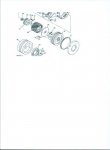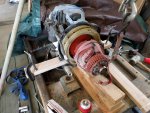serial14
Member
- 101
- 11
- 18
- Location
- Albuquerque, NM
I'm working on replacing the engine on my 802 which requires a full tear down of the generator. I've gotten everything taken off but am stuck at the stage of removing the rotor from the fly wheel. I've been working on getting it removed for several days now and have used copious amounts of PB Blaster to help loosen up any rust/dirt that maybe in the joint with no success. I've read the TMs, I've searched SS, and I've looked at lots of tear down photos and I don't think I'm missing anything on how its supposed to come apart( 5 bolts on adapter plate ).
All of the parts on the generator are in pretty good shape, not much rust, paint and coating on the rotor is still in tact. Naturally there is coat of moon dust across everything from is previous life, so I'm baffled on what could be locking it up so badly.
Does anybody have any tricks or suggestions?
All of the parts on the generator are in pretty good shape, not much rust, paint and coating on the rotor is still in tact. Naturally there is coat of moon dust across everything from is previous life, so I'm baffled on what could be locking it up so badly.
Does anybody have any tricks or suggestions?




